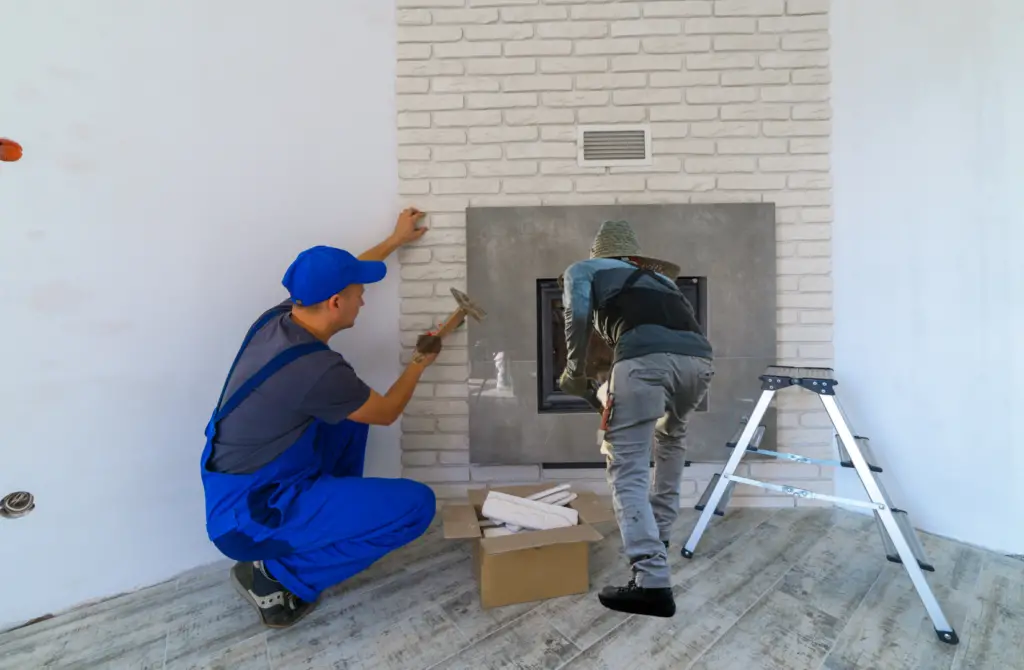Learn how to effectively remove wood-burning stoves and fireplaces, whether it’s for environmental reasons or accommodating those with wood smoke allergies, in this informative guide.
Removing a wood-burning stove or fireplace is a dusty and messy job that can take 2-5 days, but you can take it as a DIY project. The job requires a few basic tools such as a hammer, screwdriver and working gloves, and at least two people who can do heavy lifting.
This post centres on the procedures and implications of removing wood-stoves and fireplaces. Read on to find out all the essential details!

How to remove a wood-burning stove
To remove a wood-burning stove, make sure you have at least one companion who can help you lift the stove. In addition, you need a screwdriver, furniture dolly, hammer, ladder, and working gloves. Here are the steps:
- Step 1: Climb onto your roof and unscrew the top part of the outside chimney. You can easily do it with a screwdriver.
- Step 2: Remove the bottom part of the chimney. Use a hammer to remove the nails and the skirt.
- Step 3: Usually, nails are used to keep the inside chimney attached to the ceiling. Now remove the nails.
- Step 4: Go inside your home and use a small hammer or mallet to free up the inside chimney from the portion it’s connected to. Now your stove is no longer connected to a chimney.
- Step 5: Now you and your buddy do the heavy lifting. A wood stove can weigh 300-800 lbs, so don’t try to lift the whole thing up. First, remove the door—which can weigh up to 50lbs. Then if there are other removable parts of the stove, remove them.
If the appliance has sat there for years, the floor beneath it can look patched.
How to remove a fireplace
The removal of a fireplace can be a dusty and tedious process. Depending on the size, material and installation of the fireplace, the process of removal can take 2-5 days, even up to a week in some cases.
If you want to take a job as a DIY project, here is a step-by-step guide for you:
- Step 1: Remove all furniture from the room, or cover them up. Shut all doors of your home to prevent dust from entering other rooms.
- Step 2: If you want to reuse the stone or bricks use a hammer and cold chisel to dismantle the whole thing brick-by-brick. If you don’t want to reuse the bricks and stone, use a sledgehammer to break them.
- Step 3: Instead of carrying down thousands of pounds of bricks, consider throwing them out the window. Make sure nobody is underneath this!
- Step 4: Remove the whole thing up from the room and clean it up.
Notes:
- If a chimney breast supports the framing of the house, leave that chimney breast as it is.
- Wear goggles, gloves, respirators, and a hard hat to protect yourself.
- A box fan can mitigate the dust by sucking it out of the room. Consider putting a box fan in the window.
Is it a good idea to remove a wood-burning stove or fireplace?
Before you sell your home, removing a wood-burning stove or fireplace may or may not be a good idea, depending on the preference and expectation of the person you are selling the house to.
For example, if the buyer of the house is allergic to wood smoke, the removal may make the hope more appealing. In other cases, leaving the stove or fireplace as it is may be a good idea.
An environmentally conscious homeowner may want to replace an old, conventional wood-burning stove with a new EcoDesign model. EcoDesign wood-burning stoves release remarkably less smoke and thus help reduce your carbon footprint.
Modern catalytic and non-catalytic wood-burning stoves are more efficient, which means they burn less firewood than older models to produce the same amount of heat.

Does removing a wood-burning stove or fireplace devalue a house?
Not necessarily, but if the fireplace is the only way to heat the home, the removal will definitely reduce your home value. The extent to which the removal devalues your home depends on the type of stove or fireplace you have.
In general, a home with a fireplace appeals to more buyers than a one without a fireplace. Even though you have a relatively inefficient fireplace, removing it can reduce the value of your home.
With that said, any combustion-based appliance increases the rate of your home insurance. Therefore, your insurance rate will go down once you have removed a fireplace from your home.
What can you replace a wood-burning stove with?
A wood-burning stove has several major alternatives: a gas, bioethanol or electric stove, an EcoDesign wood-burning stove, or a heat pump.
A gas stove is more convenient because it allows you to enjoy the warmth and control the fire without constantly fuelling the fire. The fire does not require constant attention, so you can just sit back and relax.
A gas-burning stove does not require a chimney, but it must have a ventilation system. It’s a relatively clean option because your stove won’t emit fumes or smoke.
Just like a gas-burning stove, a bioethanol-burning stove does not require a chimney. The fire can go on burning for up to 7 hours, without requiring any attention. The appliance is pretty efficient, and emis no hazardous fumes.
Bioethanol fires are great for modern spaces. There are even some highly sophisticated units that can be connected to and controlled by your smartphone.
Using an electric stove is the cleanest and safest way to heat a home. The unit does not require a chimney, and the installation is super easy. Very little, if any, maintenance is needed.
Apart from these three alternatives, there is one more option. An alternative to an old wood-burning stove can be simply a modern one. As we have stated, modern EcoDesign wood-burning stoves are highly efficient and emit very little smoke.
Some homeowners get rid of their combustion-based appliances altogether and choose heat pumps instead, in part because they are very environmentally friendly and work smoothly with underfloor heating. In terms of its carbon footprint, a ground source or air source heat pump is far safer than a wood-burning stove.
How much does it cost to remove a fireplace?
As we have stated, fireplace removal is a dusty, messy and time-consuming job. So, you may consider hiring professionals to get the job done.
On average, the removal of a fireplace costs around $7,000. However, if you want, you can just get specific parts of the fireplace removed by a professional. For example, if you can hire someone to get the chimney removed, and pay only $1000 or less.
Dismantling the chimney breast will free up some space around the fireplace, and thus make the rest of the job easier. The removal of a chimney breast can cost around $2,500.
To get a chimney completely demolished, you will have to pay around $4,000 or more depending on the location and size of the chimney.
Conclusion
Removing a wood-burning stove is usually easier than removing a fireplace, the latter being a dirtier and messier job. If you have the time and stamina, you can take the job as a DIY project. Alternatively, you can hire a professional to get the entire job or a part of the job done.
Regardless of the particular reason you are planning to remove your wood-burning stove or fireplace, the process of removal gets a lot easier if you have a methodical approach. Hopefully, now you are better prepared to take actionable steps.
